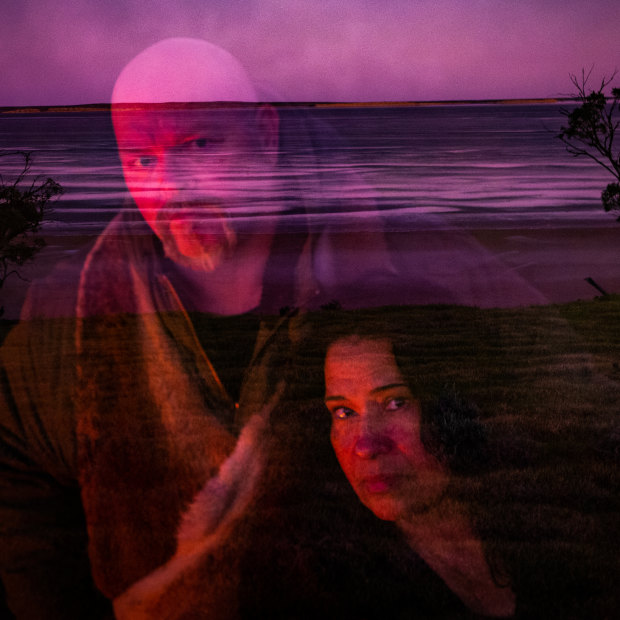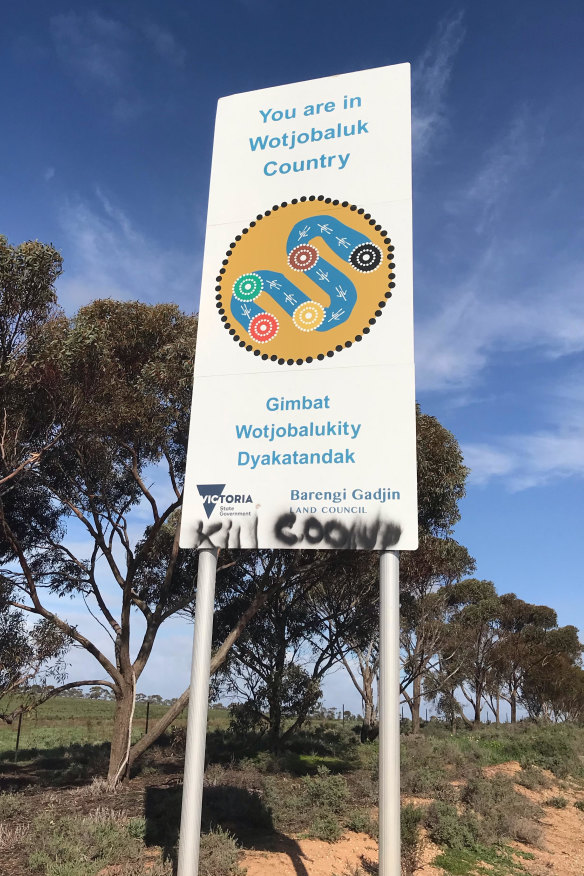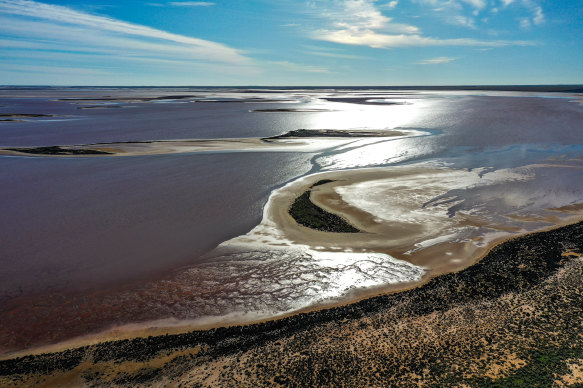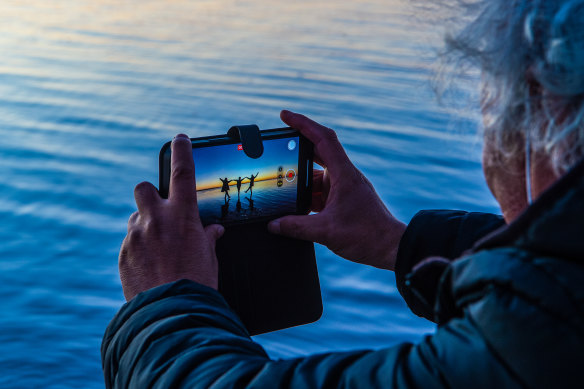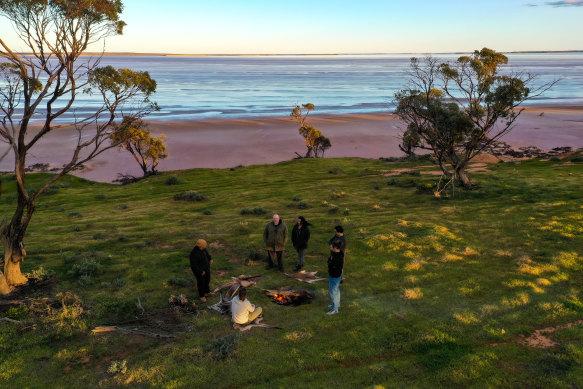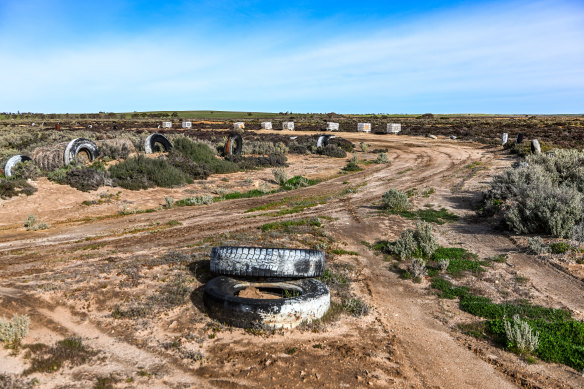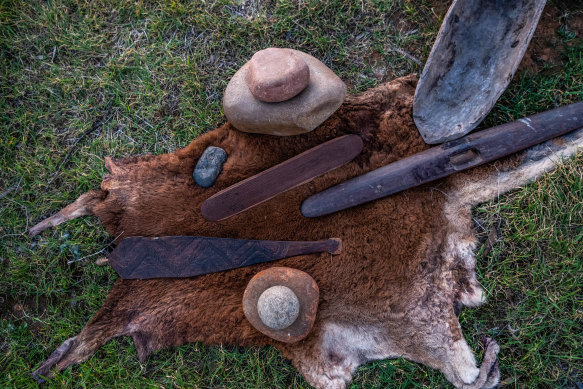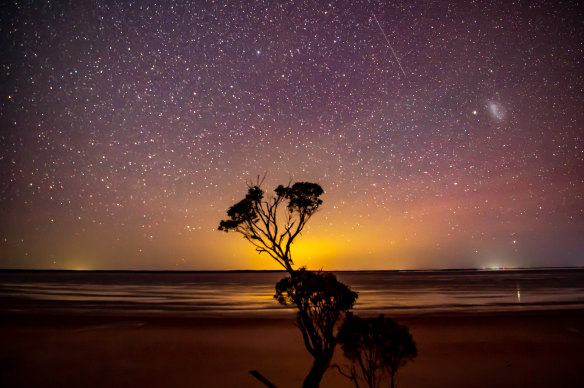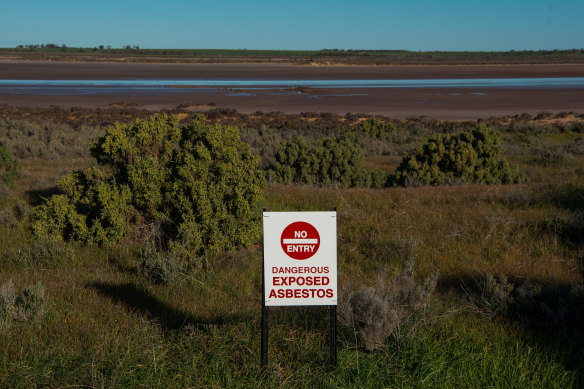By Jack Latimore
Traditional Owner of the Wergaia tribe Robby Wirramanda and wife Jackie enjoying a campfire at the northern end of Direl (Lake Tyrell).Credit:Justin McManus
Two roadside signs begin to tell the story. The first tells of a car race most locals agree has put the town of Sea Lake, in north-west Victoria, on the map over the past 47 years.
The second, a recent addition, stands eight kilometres north of town and says you have entered Wotjobaluk Country. At the bottom, spray-painted in black letters, somebody has added the words “kill coons”.
The car race, the Mallee Rally, is Australia’s oldest known off-road car race. It’s traditionally been held in June over the Queen’s Birthday long weekend. Since its first year in 1974, the event has grown to include about 100 competitors who gather to pit their vehicles against one another over an 85-kilometre circuit around the foreshore of Lake Tyrrell, which lies just to the north of Sea Lake.
A defaced sign welcomes people to Wotjobaluk Country in north-west Victoria.Credit:Jack Latimore
Sea Lake Off Road Club president George Bailey describes the event as “one of the top off-road events in Australia, when it runs”. And Buloke Shire Mayor Darryl Warren says it injects more than $250,000 into the area. The money filters through to the Lions Club, local footy clubs and school groups, as well as local businesses, Warren says.
The issue for Bailey, the club and supporters of the event is that four years ago, the rally stalled over an Aboriginal heritage ruling. The race’s abrupt cancellation came after a state heritage adviser identified traditional Aboriginal burial sites around the lake, prompting a conservation assessment. The process – paid for by the state government and administered by the shire council – was swift. An interim report immediately determined that the Mallee Rally posed too high a risk for Lake Tyrrell’s sensitive cultural heritage, which included proof of 30,000 years of Aboriginal habitation.
Supporters of the race continue to vent their frustrations. “Some people associated with our event have much more of a spiritual connection to the land than, dare I say, the people from Melbourne that are the actual ones controlling what’s happening,” one person said in a post on The Sea Lake Off Road Club’s Facebook page in July.
Dozens of other posts to the page shared similar sentiments before its administrators recently closed the comment section. The way the commenters see it, their historic cultural event was snatched away because of sensitive new views and attitudes towards “the Aboriginals”, a phenomenon many locals seem to believe has materialised out of nowhere. They cite as evidence the signs acknowledging Wotjobaluk connection to the area and what they see as an encroaching bureaucracy from the state’s capital, 350 kilometres down the highway to the south-east.
The battleground in this town between enduring Aboriginal cultural heritage and a more modern tradition shows how challenging genuine reconciliation will be as the Victorian government heads down the path to a treaty with First Peoples in the state. It shows that, as Aboriginal self-determination and governance are increasingly asserted, many will inevitably find it confronting.
Direl, or Lake Tyrell, is an Aboriginal cultural site in north-western Victoria.Credit:Justin McManus
‘A passionate story’
The campaign to return the Mallee Rally has political backing in at least one high place. Victorian Opposition Deputy Leader Peter Walsh, who is also the state Nationals Party leader and the shadow spokesperson for Aboriginal affairs, is right behind it.
Walsh sought answers in parliament in April 2019 – the year the race was cancelled – claiming the state Labor government had reneged on a promise to help the race’s organisers comply with a cultural heritage assessment. In July of that year, Walsh visited the event’s organisers in Sea Lake and released a statement saying that the race had been operating successfully for 47 years and the committee had worked with traditional owners over that time to protect Lake Tyrell.
“History will show the Sea Lake community as true environmental and cultural custodians of the lake,” he said.
Since then, Walsh, whose Coalition opposition has announced its support for the treaty process, has reaffirmed his commitment to supporting the campaign for the revival of the race. On social media last year, he wrote: “I am still doing all I can to bring back the Sea Lake Mallee Rally.”
The area’s local member, Ali Cupper, an independent, has also expressed her support for the race’s return, pressing Victorian Aboriginal Affairs Minister Gabrielle Williams in parliament in 2021 on what assistance the government would provide to revive the event.
Warren, the mayor, is quietly confident that the Mallee Rally will be back. In his view, it just takes people working together in the same direction.
“It’s a passionate story, whichever way you talk,” he says. “But the way ahead is if everyone sits down and takes a big, deep breath. If there is a willingness from everybody to sit down and be honest, open and frank about what the issues are, [the rally] can happen again.”
Warren, 70, a former clerk of the magistrate’s court who has Aboriginal heritage from a Yorta Yorta great-grandmother – a First Nations group situated more than 100 kilometres to the east – says the obstacles holding up the return of the event are “not insurmountable”.
“These are farming people who’ve endured drought and all sorts of things. They’re not going to give up. They don’t give up,” he says.
Pink salt country
At 20,860 hectares, Lake Tyrrell is Victoria’s largest inland saltwater lake and forms the centrepiece of the Direl cultural landscape. Occupation of the site by First Peoples has been dated to about 30,000 years ago, making it comparable to the nearby UNESCO World Heritage-listed Willandra Lakes Region in south-western NSW. It is a remnant of the ancient Lake Bungunnia, a mega-lake that connected to the Willandra Lakes Region in the Pleistocene period.
Kennedy likens the destruction of Direl and the effort to revive the Mallee Rally as like somebody wanting to bomb the Vatican.
These days, the Direl cultural landscape contains several known culturally sacred and archaeologically significant places. Many more are likely to be concealed in the lake’s eastern dunes. Its present-day cultural heritage connections extend to First Nations groups that include the Wergaia (Wotjobaluk), Barapa Barapa, Yung Balug of the DjaDja Wurrung, Jaadwa, Jadawadjali, Wamba Wamba, Jupagulk and others to the north.
The lake itself is dry, however, for about a third of the year; it may hold three to six inches of water, which migrates across the bed of the lake with the wind. Some of its water comes from ground springs, and because it is so salt-laden, the surface perfectly mirrors the sky – or “direl” in the local traditional language. In the warmer months, the shallow waters quickly evaporate, leaving a dry pink-white salt crust, which, on the western side of the lake, is thick enough to have supported commercial salt mining enterprises for more than a century.
Tourists have swarmed to Lake Tyrrell since photos went viral eight years ago.Credit:Justin McManus
After a holiday snap of the lake’s reflection went viral on social media about eight years ago, the lake became a popular international tourist destination, particularly at its south-eastern shoreline, about seven kilometres outside Sea Lake.
The first thing you notice about the lake at its northern end is the lack of wildlife. This area contains the lake’s only remnant native vegetation, but there are no waterfowl in sight, nor can a kangaroo or wallaby be spotted at dusk.
The absence is noted by Tatti Tatti, Wadi Wadi and Wamba Wamba man Brendan Kennedy, whose First Nations groups are connected with the north-east end of the lake. The area holds Box Gully, a registered site containing the hearths and cooking ovens of the local Aboriginal people from past millennia. The discovery, which included the remains of cooked bettong – a small marsupial – placed the Aboriginal occupation in the same late Pleistocene period of deep time history as Mungo man and Mungo woman.
Traditional owner of the Wergaia tribe Robby Wirramanda Knight brought his family to the northern end of Direl to cure kangaroo skins with salt.Credit:Justin McManus
Kennedy wants regular cultural flows of fresh water into the lake, via the Tyrrell Creek, which feeds from the Avoca River to the east. Water is prevented from flowing regularly into the river’s tributaries by catchment management authorities and landholders who use channels and dams to divert water from the natural Avoca River system, he says.
“The lake is meant to have water in it. It’s meant to have native vegetation all around it. It needs a whole rehabilitation process,” Kennedy says. “There’s none of our totemic, spiritual species there at all. No pelican, no red tail cockatoos, no quolls. You don’t even see any goanna.”
Wergaia traditional owners Robby and Jackie Wirramanda Knight maintain a connection with Direl through their art and cultural practices. The couple have taken custodianship of numerous artefacts unearthed by neighbouring farmers or re-discovered on the banks and dunes.
“The cultural significance of the lake is everywhere. It’s in the trees, it’s in the lake, it’s in the ground,” says Robby Wirramanda Knight, who considers it his duty to preserve the site.
“There’s nothing positive that I can see that can come out of the Mallee Rally for the lake. Whether it is the cultural heritage or the environmental side of things, when you have super-powered vehicles tearing through, nothing stays here,” he says.
Mallee Rally and four-wheel drive tracks circle the southern end of the lake.Credit:Justin McManus
‘We want our lake back’
When it considers the protection of heritage sites, Aboriginal Victoria (the Victorian government department replaced by First Peoples – State Relations last year) classes a significant amount of damage to be 10 square metres, says Wirramanda Knight. At Direl, the racetrack is about 100 kilometres long and 50 metres wide.
“That’s a minimum of 50,000 square metres per kilometre of damage.”
Warren describes the event’s organisers as “accommodating” in their consultations with the state’s cultural heritage advisers and says they are looking at alternative options for a new track, which would take them outside any contentious areas.
Artefacts have been found in and around Direl.Credit:Justin McManus
But Sea Lake Off Road Club’s Bailey describes the event as “too important for locals to walk away from” and says the uniqueness of the track made it one of the top off-road races in the country.
Bailey says he has looked at alternative options with and without the participation of traditional owners, but none of the options offer as interesting a circuit. An alternative proposal, that the race take place on private farmland that is cultivated each year, was hard to sell to farmers worried about their crops.
Wirramanda Knight says the co-ordinators of the event have attempted to contact him countless times and they “only want to hear what they want to hear”. It’s not just the race that tears the delicate foreshore up, he says. The damage begins weeks earlier when the graders rumble in to prepare the circuit. Kennedy likens the destruction of Direl and the effort to revive the Mallee Rally to somebody wanting to bomb the Vatican.
Traditional owners have suggested building a planetarium near the lake to share the traditional astronomy of the Booroung people, one of Direl’s Indigenous tribes.Credit:Justin McManus
“We don’t want the rally back. We want our lake back. We want Direl back,” Kennedy says.
Last month, a group of traditional owners made an urgent application to the Commonwealth seeking protection for the whole of Direl under the Aboriginal and Torres Strait Island Heritage Protection Act. The application to Environment Minister Tanya Plibersek raised the group’s “serious and ongoing concerns” over multiple “serious and imminent” threats and desecration “to our tangible and intangible cultural heritage”.
The application lists the threat posed by the Mallee Rally and a large caravan park development that proceeded on private property outside Sea Lake without a required cultural heritage management plan. Then there is an international mining company that the group says extracts about 100,000 tonnes of salt from the Direl site each year, worth about $45 million. The traditional owners’ group alleges the company poses a serious environmental risk through its use of asbestos sheeting on the lake bed.
Mining activity at Direl has left asbestos on the surrounding land.Credit:Justin McManus
The group proposes to build on sustainable tourism options already being established around the Direl site, such as Indigenous art centres, photographic tourism and astronomical festivals. It intends to pursue a world heritage listing overlay for the entire site.
Another plan involves the establishment of a cultural centre and planetarium to share the traditional astronomy of the Booroung people, one of Direl’s Indigenous tribes.
The group says it hopes such a centre will encourage the repatriation from England of the Direl Barks, which record the arrival of Europeans to the lake.
“A planetarium … gives us something to work towards, to have a keeping place for our cultural knowledge, for our language,” says Wirramanda Knight, as he arranges some fresh kangaroo skins he hunted with his sons on farmland away from the lake the previous night. He and his family have brought the skins to the lake to cure them with salt.
“We want to see some form of economic opportunity that we’ve been shut out of for 200 years,” he says.
“These are the things we sit and speak of as traditional owners.”
The Morning Edition newsletter is our guide to the day’s most important and interesting stories, analysis and insights. Sign up here.
Most Viewed in National
Source: Read Full Article
